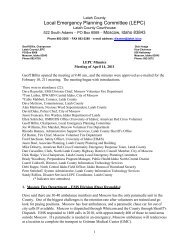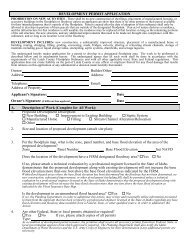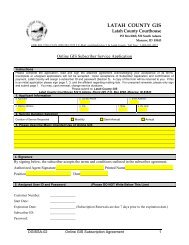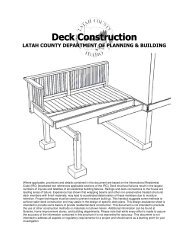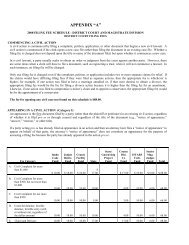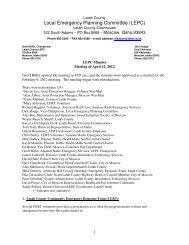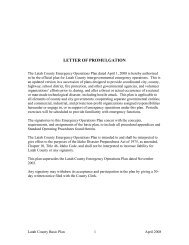LATAH COUNTY, IDAHO MULTI-HAZARD MITIGATION PLAN
LATAH COUNTY, IDAHO MULTI-HAZARD MITIGATION PLAN
LATAH COUNTY, IDAHO MULTI-HAZARD MITIGATION PLAN
You also want an ePaper? Increase the reach of your titles
YUMPU automatically turns print PDFs into web optimized ePapers that Google loves.
‣ Extreme precipitation and runoff events<br />
‣ Inadequate urban drainage systems overwhelmed by small intense rainstorms<br />
‣ Dam failures<br />
Debris flows are hazards that are closely related to flash floods, triggered by heavy rainfall, are more<br />
commonly considered as a type of earth movement (a ―geological hazard).<br />
Extreme Precipitation and Runoff Events: Events that may lead to flash flooding include:<br />
‣ Significant rainfall and/or snowmelt on frozen ground in the winter and early spring months.<br />
‣ High intensity thunderstorms, usually during the summer months.<br />
‣ Rainfall onto burn areas (such as those affected by wildfire) where high heat has caused the soil to<br />
become hydrophobic or water repellent which dramatically increases runoff potential during rain.<br />
The 2007 fire season saw approximately 2 million acres burn in Idaho. Much of the burned terrain<br />
will have water repellent soils for the next 2 to 4 years and higher probability of experiencing flash<br />
floods and debris flows than it normally would.<br />
Flash floods from thunderstorms do not occur as frequently as those from general rain and snowmelt<br />
conditions but are far more severe. The onset of these flash floods varies from slow to very quick and is<br />
dependent on the intensity and duration of the precipitation and the soil types, vegetation, topography,<br />
and slope of the basin. When intensive rainfall occurs immediately above developed areas, the flooding<br />
may occur in a matter of minutes. Sandy soils and sparse vegetation, especially recently burned areas, are<br />
conducive to flash flooding. Mountainous areas are especially susceptible to damaging flash floods, as steep<br />
topography may stall thunderstorms in a limited area and may also funnel runoff into narrow canyons,<br />
intensifying flow. A flash flood can, however, occur on any terrain when extreme amounts of precipitation<br />
accumulate more rapidly than the terrain can allow runoff. Flash floods are most common in Idaho in the<br />
spring and summer months due to thunderstorm activity. 25<br />
Flooding from ice jams is relatively common in Idaho. Ice jam formation depends on air temperature and<br />
physical conditions in the river channel. Ice cover on a river (a precursor to the ice jam) is formed when<br />
water reaches the freezing point and air temperature is sub‐freezing; large quantities of ice are produced,<br />
flow downstream, and consolidate.<br />
An ice jam is a stationary accumulation of ice that restricts flow. Ice jams can cause considerable increases<br />
in upstream water levels, while at the same time downstream water levels may drop, exposing water<br />
intakes for power plants or municipal water supplies. Types of ice jams include freezeup jams, made<br />
primarily of frazil ice; breakup jams, made primarily of fragmented ice pieces; and combinations of both.<br />
River geometries, weather characteristics, and floodplain land‐use practices contribute to the ice jam<br />
flooding threat at a particular location. Ice jams initiate at a location in the river where the ice transport<br />
capacity or ice conveyance of the river is exceeded by the ice transported to that location by the river's<br />
flow.<br />
Change in Slope: The most common location for an ice jam to form is in an area where the river slope<br />
changes from relatively steep to mild. Since gravity is the driving force for an ice run, when the ice reaches<br />
25 Idaho Bureau of Homeland Security. 2007. State of Idaho Hazard Mitigation Plan. Hazard Mitigation Program.<br />
November 2007. Available online at http://www.bhs.idaho.gov/Resources/PDF/SHMPFinalw‐signatures.pdf.<br />
46



